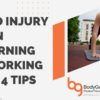Education is always one of the points of emphasis as a physical therapist as we want to ensure the understanding of the anatomy, joint biomechanics, and how it can impact movement and pain. For many patients’, pain is a signal of soft tissue or joint injury but that is not always the case especially for someone with chronic pain.
‣Pain comes in many forms.
The most common are nociceptive pain which is pain perceived from sensory input due to tissue or joint injury. Other forms of pain may be due to hypersensitivity of the nervous system after an initial insult such as peripheral nerve sensitization and central sensitization resulting in pain perceived during non-painful stimuli.
‣This leads us to the neuromatrix theory of pain.
It proposes that a neurosignature (pattern of impulses) for the pain experience is based on a network of synapses or electrical signals throughout the body to multiple areas of the brain. These patterns of synapses are modified based on different sensory inputs, past experiences, stressors both physical and psychological, as well as genetic factors. After an injury, these factors can alter the ability of the body to regulate and return to a homeostatic state.
An example of this change in homeostasis is the increase in cortisol released after an injury. Cortisol increases glucose production in attempts to rapidly respond to the injury and recover homeostasis. Unfortunately, it also suppresses the immune system and inhibits bone formation. Therefore, excessive amounts of cortisol in the body can result in weakness, muscle pain, acceleration of neural degeneration, and breakdown of bone.
Luckily, the nervous system has neuroplastic properties in that it is capable of modifying neuro-signatures to positively alter awareness of movement and pain. Proper education concerning pain and the science behind it is necessary to be able to reconceptualize the nervous system’s interpretation of pain or the threat of pain as it does not always indicate injury of tissues.
Physical therapists are appropriately positioned to not only provide this education but also gradually introduce safe movements to facilitate the independence of mobility as well as ownership of their lives. The youtube link below is a good supplement to reiterate the points of emphasis noted above.
Authored By: DR. ESTHER KIM PT, DPT
If you liked this article please give us feedback and join the conversation. We would love to hear your suggestions on other science, anatomy, or movement topics you’d like to learn more about! Find us on Facebook, Instagram, and Twitter @BodyGearsPT.
References:
- Louw, Adriaan, Ina Diener, David S. Butler, and Emilio J. Puentedura. “The effect of neuroscience education on pain, disability, anxiety, and stress in chronic musculoskeletal pain.” Archives of physical medicine and rehabilitation 92, no. 12 (2011): 2041-2056.
- Melzack, Ronald. “Pain and the neuromatrix in the brain.” Journal of dental education 65, no. 12 (2001): 1378-1382.
- https://www.ispinstitute.com/free-information/






